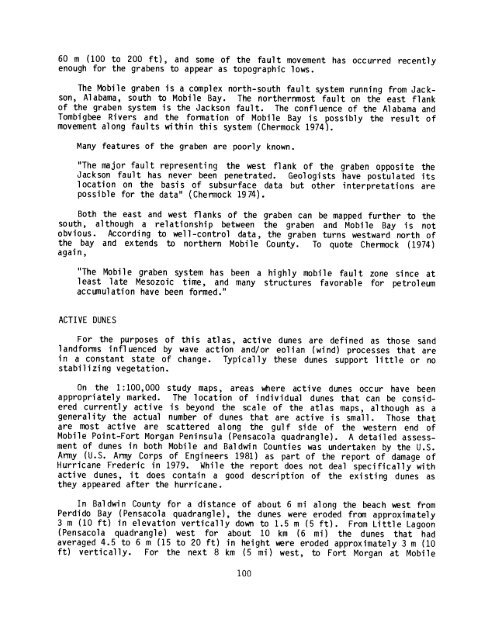ecological characterization atlas of coastal alabama - Data Center
ecological characterization atlas of coastal alabama - Data Center
ecological characterization atlas of coastal alabama - Data Center
You also want an ePaper? Increase the reach of your titles
YUMPU automatically turns print PDFs into web optimized ePapers that Google loves.
60 m (100 to 200 ft), and some <strong>of</strong> the fault movement has occurred recently<br />
enough for the grabens to appear as topographic lows .<br />
The Mobile graben is a complex north-south fault system running from Jackson,<br />
Alabama, south to Mobile Bay . The northernmost fault on the east flank<br />
<strong>of</strong> the graben system i s the Jac kson faul t . The confl uence <strong>of</strong> the Al abama and<br />
Tombigbee Rivers and the formation <strong>of</strong> Mobile Bay is possibly the result <strong>of</strong><br />
movement along faults within this system (Chermock 1974) .<br />
Many features <strong>of</strong> the graben are poorly known .<br />
"The major fault representing the west flank <strong>of</strong> the graben opposite the<br />
Jackson fault has never been penetrated . Geologists have postulated its<br />
location on the basis <strong>of</strong> subsurface data but other interpretations are<br />
possible for the data" (Chermock 1974) .<br />
Both the east and west flanks <strong>of</strong> the graben can be mapped further to the<br />
south, although a relationship between the graben and Mobile Bay is not<br />
obvious . According to well-control data, the graben turns westward north <strong>of</strong><br />
the bay and extends to northern Mobile County . To quote Chermock (1974)<br />
again,<br />
"The Mobile graben system has been a highly mobile fault zone since at<br />
least late Mesozoic time, and many structures favorable for petroleum<br />
accumulation have been formed ."<br />
ACTIVE DUNES<br />
For the purposes <strong>of</strong> this <strong>atlas</strong>, active dunes are defined as those sand<br />
landforms influenced by wave action and/or eolian (wind) processes that are<br />
in a constant state <strong>of</strong> change . Typically these dunes support little or no<br />
stabilizing vegetation .<br />
On the 1 :100,000 study maps, areas where active dunes occur have been<br />
appropriately marked . The location <strong>of</strong> individual dunes that can be considered<br />
currently active is beyond the scale <strong>of</strong> the <strong>atlas</strong> maps, although as a<br />
generality the actual number <strong>of</strong> dunes that are active is small . Those that<br />
are most active are scattered along the gulf side <strong>of</strong> the western end <strong>of</strong><br />
Mobile Point-Fort Morgan Peninsula (Pensacola quadrangle) . A detailed assessment<br />
<strong>of</strong> dunes in both Mobile and Baldwin Counties was undertaken by the U .S .<br />
Army (U .S . Army Corps <strong>of</strong> Engineers 1981) as part <strong>of</strong> the report <strong>of</strong> damage <strong>of</strong><br />
Hurricane Frederic in 1979 . While the report does not deal specifically with<br />
active dunes, it does contain a good description <strong>of</strong> the existing dunes as<br />
they appeared after the hurricane .<br />
In Bal dwi n County for a di stance <strong>of</strong> about 6 mi al ong the beach west from<br />
Perdido Bay (Pensacola quadrangle), the dunes were eroded from approximately<br />
3 m (10 ft) in elevation vertically down to 1 .5 m (5 ft) . From Little Lagoon<br />
(Pensacola quadrangle) west for about 10 km (6 mi) the dunes that had<br />
averaged 4 .5 to 6 m(15 to 20 ft) in height were eroded approximately 3 m (10<br />
ft) vertically . For the next 8 km (5 mi) west, to Fort Morgan at Mobile<br />
100
















